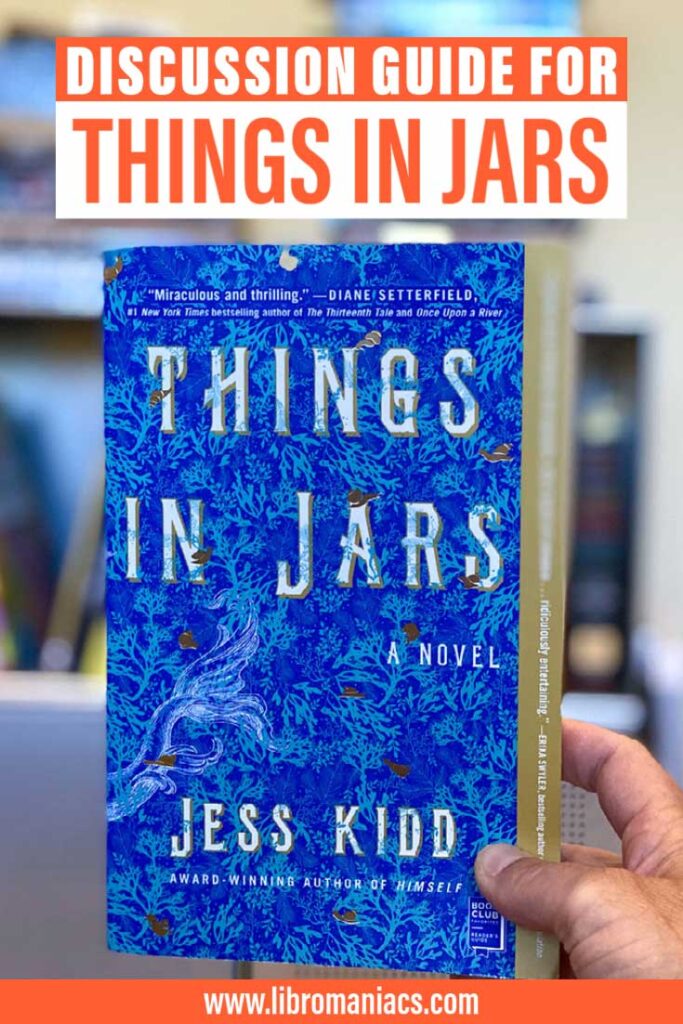This novel by Jess Kidd is a great choice for book club. There is a quirky cast of characters, dark doings and a plucky heroine. You won’t have much trouble finding something to talk about, but to help you get started, we’ve got some Things in Jars Book Club questions for you.
Our Things in Jars discussion guide follows our usual format. We have a synopsis (just to remind you of the book’s rough outline). We’ve provided 10 discussion questions and we’ve pulled some provocative quotes from reviews that you can use to stimulate conversation.

Things in Jars Synopsis
Things in Jars, by Jess Kidd
Bridie Devine—flame-haired, pipe-smoking detective extraordinaire—is confronted with the most baffling puzzle yet: the kidnapping of Christabel Berwick, secret daughter of Sir Edmund Athelstan Berwick, and a peculiar child whose reputed supernatural powers have captured the unwanted attention of collectors in this age of discovery.
Winding her way through the sooty streets of Victorian London, Bridie won’t rest until she finds the young girl, even if it means unearthing secrets about her past that she’d rather keep buried. Luckily, her search is aided by an enchanting cast of characters, including a seven-foot-tall housemaid; a melancholic, tattoo-covered ghost; and an avuncular apothecary. But secrets abound in this foggy underworld where nothing is quite what it seems.
Blending darkness and light, Things in Jars is a stunning, “richly woven tapestry of fantasy, folklore, and history” (Booklist, starred review) that explores what it means to be human in inhumane times.
Things in Jars Book Club Questions
- The merrows are part of Ireland’s mythological traditions. But rather than a traditional mermaid myth, where they lure men into the deep, the merrows often left the sea for a human mate. As the legend goes, the husbands would hide the merrow’s magic cap, preventing her from going back to the ocean. What does this say to you about gender roles and the commitment of marriage?
- Convention was important during the Victorian era. Gender and social status dictated everything. Men were in the public sphere and women were expected to hew to the domestic sphere. Yet, our plucky Bridie managed to buck the prevailing culture. What are the many ways that she pulls that off?
- We are accustomed to having our detectives get things right. But in the case of Eliza, Bridie got that quite wrong. How did that revelation sit with you?
- There were quite a few stories within this story. There was Mrs Bibby’s childhood stories as told to Christabel. But there is also Christabel’s own family story, Rudy and Bridie’s past and Cora’s circus experience. How do these storylines intersect with the main narrative.
- As someone who never utters one word, Christabel still manages to be quite a character. Discuss the ways that the author developed Christabel’s character.
- This book explores a lot of hard science but there is also a huge dose of magical realism, the occult and mythology. How did that balance work for you?
- Cora is a seven foot tall former circus act who cleans with indifference and boils up inedible meats. She’s also very loyal to Bridie and has a tender side. Would you hire her?
- “London has never seen rain like it. And now, all over the city the streets run with water, this foul gray-foamed downpour. As if God has emptied his washtub after boiling Satan’s inexpressibles in it?” This passage is a great example of the author’s ability to pull up vivid imagery. But the use of “inexpressibles” is also ever-so Victorian. How did you react to the descriptive language in the novel?
- The Victorian era was a sort of golden age for science. Botanists were cataloging plants, Darwin was developing his evolutionary theories and the British Museum was filling with looted plunder from ancient Egypt. Things in jars, were an actual thing in Victorian England. How do you feel about these scientific curiosities? Where is the line between legitimate scientific inquiry and exploitation?
- Have you ever seen a thing in a jar?
Discussion-provoking Reviews of Things in Jars
“This is compulsive and magical reading fare, such infernally dark matter, but shot through with light by Bridie, Cora, Ruby and Inspector Valentine Rose”
“Kidd seamlessly weaves together a story filled with magic, strong women, and those who long to possess those who are different.”
“I found the writing style to be extremely difficult to understand, to the point where I had no idea what was going on in the first 50 pages. The excessive descriptions just don’t do it for me. Every time a person is introduced, we read extensively about every feature on their face, every article of clothing, their posture and body shape, all using florid metaphors that don’t make any sense to me.”
“…Disappointingly, the story began to lose its cut and thrust in the middle stages. I was even (gulp) bored for several chapters. The treacherous ocean had become a gentle millpond and I wanted more. Ah, but wonderful Jess Kidd redeems herself with a poignant scene at the book’s dénouement; a passage so pitiful, so heroic, that the scales on the back of my neck stood on end and my gills began to gasp. “Bravo, Jess!” I squeaked, clapping my fins together.”
“…While often beautiful, atmospheric and descriptive, [the writing style] sometimes left me feeling like it was too much work reading it. In addition, I had trouble keeping track of all the characters…”
Have a listen on Audible. Try audio books for free for 30 days.
Share this Things in Jars discussion guide on Pinterest:


